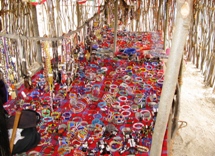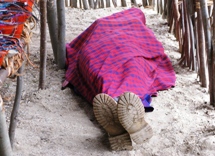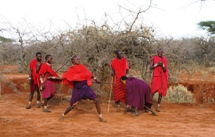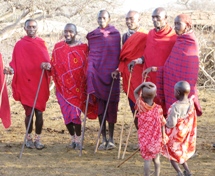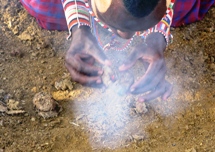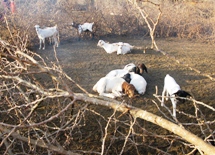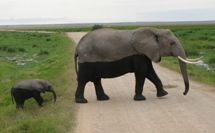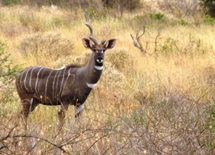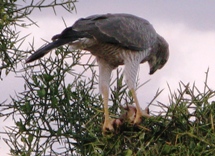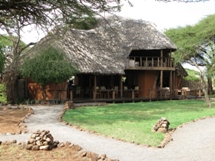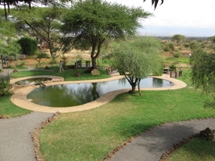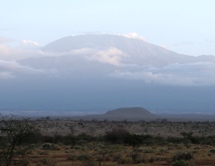Kenya : Day Two : Porini Amboseli Camp to Tawi Lodge
Porini Amboseli Camp, although owned and run by Gamewatchers Safaris, is largely staffed by local Maasai. It is designed to be very eco-friendly, with cold running water (but with hot bucket showers when requested), solar power and so on. However when it gets cold at night, as it often does, hot water bottles can be provided!
A particular feature was the camp shop, which we visited immediately after breakfast, and which had a wide variety of local Maasai goods on sale (![]() ), although the shop attendant (
), although the shop attendant (![]() ) had obviously had a late night the day before!
) had obviously had a late night the day before!
We then went out on a game drive, during which our Maasai guide introduced us to a number of his countrymen, who entertained us with a spear-throwing competition (![]() ).
).
They certainly appeared to achieve considerable distances, but I did wonder what the outcome might be if we could persuade a world-class javelin competitor to come out on a trip like this. True, he would need to accustom himself to the different weight and balance of the Maasai spear, and then practice a bit, but it would be very interesting to see how he measured up to the Maasai.
The following visit to their home village was quite fascinating. The villagers are a magnificent sight, in their colourful robes (![]() ), although their actual dwellings are extremely primitive - much more so than the circular hut typically found in rural Africa. Made out of mud plastered onto a sort of wooden framework (
), although their actual dwellings are extremely primitive - much more so than the circular hut typically found in rural Africa. Made out of mud plastered onto a sort of wooden framework (![]() ), below, the space inside the hut is incredibly restricted (
), below, the space inside the hut is incredibly restricted (![]() ), below, and uncomfortable looking, with virtually no light to see by.
), below, and uncomfortable looking, with virtually no light to see by.
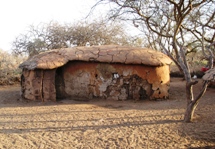
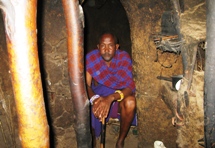
This is a cultural, rather than economic, choice, although the whole scenario became totally incongruous when we observed that most of the villagers were carrying state-of-the-art mobile (cell) phones. During our visit we were shown how to create fire out of just a few pieces of grass, and sticks (![]() ), and further observed how the villagers' cattle are kept safe from predators within a thorn-encased boma (
), and further observed how the villagers' cattle are kept safe from predators within a thorn-encased boma (![]() ).
).
During the following game drive, the highlight was to come across the actual elephant herd made famous in a number of books and TV documentaries, when headed by Echo, an elephant matriarch who was exhaustively studied for over 30 years by the ethnologist Cynthia Moss. Echo actually became the herd matriarch at the age of 23, an unusually young age, and died at the age of 65, in 2008. It was Echo's continuing family, now led by Ella that we were able to observe in some detail - quite a treat.
Our guide showed his especial skills by positioning our vehicle well ahead of the herd, but at the exact spot that he reckoned they would cross the road ahead of us (![]() ), so that we could view them, almost within touching distance, without disturbing them by roaring up to them. As you can see, they had recently crossed some water, leaving them with a distinctive 'tidemark'. Further on we spotted a lesser kudu (
), so that we could view them, almost within touching distance, without disturbing them by roaring up to them. As you can see, they had recently crossed some water, leaving them with a distinctive 'tidemark'. Further on we spotted a lesser kudu (![]() ) and a goshawk, busy devouring its prey (
) and a goshawk, busy devouring its prey (![]() ).
).
We then came across the unusual gerenuk antelope (![]() ), below. Seen like this it may not immediately impress, but its name means 'giraffe neck' in Somali, and it uses its unusually long neck, as seen below (
), below. Seen like this it may not immediately impress, but its name means 'giraffe neck' in Somali, and it uses its unusually long neck, as seen below (![]() ), to locate hard-to-reach food so that it can survive among other plant eating animals - a quite bizarre sight.
), to locate hard-to-reach food so that it can survive among other plant eating animals - a quite bizarre sight.
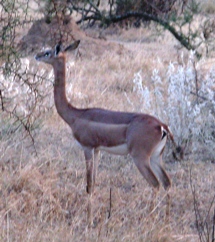
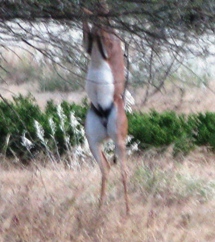
In late afternoon we arrived at our final night's destination in Amboseli - Tawi Lodge, located in the same, Selenkay, Conservancy as Porini Amboseli, but much closer to the actual Amboseli National Park.
Tawi is quite a different sort of camp, consisting as it does of a dozen stone and thatch cottages (![]() ), accompanied by a great looking swimming pool (
), accompanied by a great looking swimming pool (![]() ). Again, it is quite eco-friendly, but with generator power, in addition to solar. The rooms themselves are quite delightful, with four poster beds (
). Again, it is quite eco-friendly, but with generator power, in addition to solar. The rooms themselves are quite delightful, with four poster beds (![]() ), below, and elegant bathrooms (
), below, and elegant bathrooms (![]() ), below. Bath robes, flip flops and large fluffy towels are also supplied. Apparently if you are here on honeymoon there are also surprises provided. . . .
), below. Bath robes, flip flops and large fluffy towels are also supplied. Apparently if you are here on honeymoon there are also surprises provided. . . .
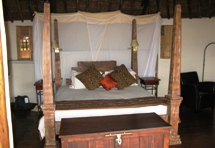
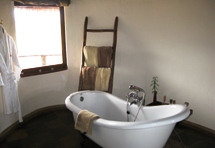
From here it is possible to see Tanzania's Mount Kilimanjaro, although the climactic conditions weren't all that favourable for achieving this. However in late afternoon we were rewarded by a distant view (![]() ) of this iconic landmark (the vague shape reaching up into the sky - not the small dark mound down below!).
) of this iconic landmark (the vague shape reaching up into the sky - not the small dark mound down below!).
| Back to previous page (Day 1) | Forward to next page (Day 3) |
